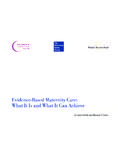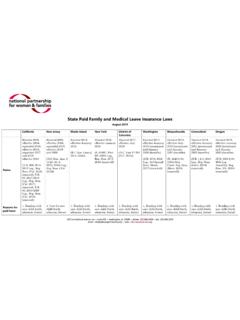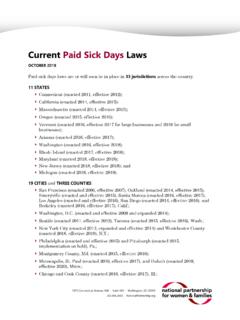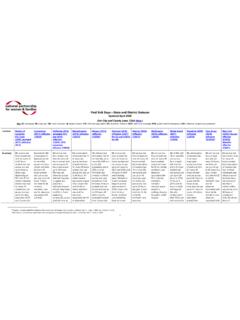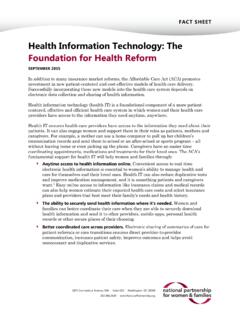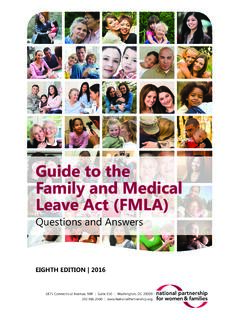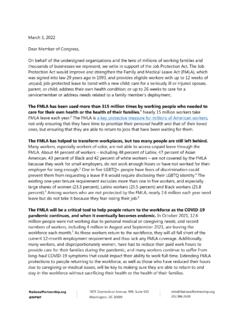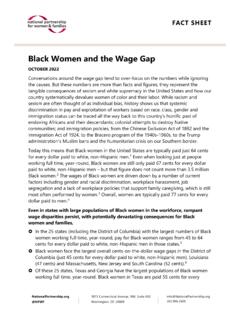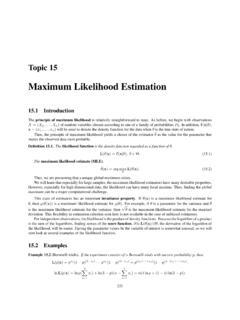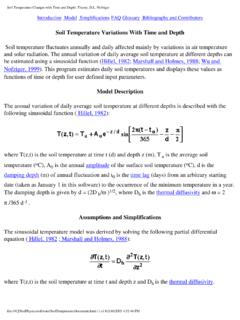Transcription of America’s Women and the Wage Gap
1 FACT SHEET. America's Women and the Wage Gap JANUARY 2022. Nationally, the median annual pay for a woman who Wage gap between men and holds a full-time, year-round job is $50,982 while the Women by state, per dollar median annual pay for a man who holds a full-time, $ $ $ year-round job is $61,417. This means that, overall, $ Women in the United States are paid 83 cents for Wyoming (1). Utah (2) $ every dollar paid to men, amounting to an Louisiana (3). Oklahoma (4). $ $ 1. annual gender wage gap of $10,435. Alabama (5). South Dakota (6). $ $ Idaho (7) $ These numbers are more than facts and figures; they Indiana (8) $ North Dakota (9) $ represent the tangible consequences of sexism and West Virginia (10) $ Mississippi (11) $ white supremacy in the United States and how our South Carolina (12) $ Montana (13) $ country systematically devalues Women of color and New Mexico (14) $ Michigan (15) $ their labor.
2 This persistent, pervasive wage gap is Iowa (16) $ Illinois (17) $ driven in part by gender and racial discrimination, Washington (18) $ $ workplace harassment, job segregation and a lack of Ohio (19). Pennsylvania (20) $ workplace policies that support family caregiving, Arkansas (21). Texas (22). $ $ 2. which is still most often performed by Women . Kansas (23) $ Kentucky (24) $ Virginia (25) $ Data for 2020 reflect the unprecedented economic Colorado (26) $ Nebraska (27) $ shock of the coronavirus pandemic, including mass Maine (28) $ Missouri (29) $ layoffs especially in many low-wage, Women - Oregon (30) $ New Jersey (31) $ dominated occupations and increased family Tennessee (32) $ Georgia (33) $ caregiving demands that pushed many Women out of Wisconsin (34) $ $ jobs or into part-time work.
3 Women of color Massachusetts (35). Minnesota (36) $ experienced these pressures New Hampshire (37). Florida (38). $ $ Those who were able to remain employed full-time District of Columbia (39). Delaware (40). $ $ throughout the year tended to be in higher-paid jobs, Arizona (41) $ Connecticut (42) $ skewing the wage gap relative to a typical year. Alaska (43) $ Rhode Island (44) $ North Carolina (45) $ The gender wage gap is a measure of just how far our New York (46) $ Nevada (47) $ nation still has to go to ensure that Women can California (48) $ Maryland (49) $ participate fully and equally in our economy and it Hawaii (50) $ Vermont (51) $ is widest for many Women of color. Among Women who hold full-time, year-round jobs in the United States, white, non-Hispanic Women are paid 79 cents, Black Women are typically paid 64.
4 1875 Connecticut Avenue, NW, Suite 650 @NPWF Washington, DC 20009 cents, Native American Women 60 cents, Latinas just 57 cents, and Asian American and Pacific Islander Women are paid as little as 52 cents, as Burmese Women are, and just 85. 4. cents overall for every dollar paid to white, non-Hispanic men. The wage gap also varies by state and congressional district but spans nearly all corners of the country.* In Wyoming, for example, Women are paid 65 cents for every dollar paid to men (a gap of 35 cents for every dollar), while in Vermont are paid 91 cents for every dollar paid to men (a gap of 9 cents) (see chart).5 In 420 out of 435 congressional districts (97 percent), the median yearly pay for Women who work full time, year-round is less than 6. the median yearly pay for men. What Does the Wage Gap Mean for America's Women ?
5 On average, Women employed full time in the United States lose a combined total of 7. nearly $930 billion every year due to the wage gap. These lost wages mean Women and their families have less money to support themselves, save and invest for the future, and spend on goods and services. Women , their families, businesses and the economy suffer as a result. If the annual gender wage gap were eliminated, on average, a working woman in the United States would have enough money for approximately: 8. More than 13 additional months of child care;. One additional year of tuition and fees for a four-year public university, or the full 9. cost of tuition and fees for a two-year college;. 10. Nearly seven additional months of premiums for employer-based health insurance;. 11. More than 74 weeks of food (more than one year's worth).
6 12. More than six more months of mortgage and utilities payments;. 13. More than nine additional months of rent;. 14. Up to additional years of birth control;. 15. Or enough money to pay off student loan debt in just under four years. Women , Families and the Country Cannot Afford Discrimination and Lower Wages In the United States, mothers are breadwinners in 40 percent of families with children under 18 each year and about 70 percent will be the primary earner at some point in their first 18 years of * Due to pandemic-related disruptions in data collection, the Census Bureau will not release its standard 1-year estimates for the 2020 American Community Survey. As a result, this fact sheet provides the previous year's data for state- and congressional district- level wage gaps and other ACS-based analyses.
7 NATIONAL PARTNERSHIP FOR Women & FAMILIES | FACT SHEET | AMERICA'S Women AND THE WAGE GAP. 2. Each year, 48 percent of white mothers, 49 percent of Latina mothers, 79 percent of Black mothers, 64 percent of Native American mothers and 43 percent of 17. Asian/Pacific Islander mothers are breadwinners in their households. Yet the wage gap for mothers is larger than for Women overall. Mothers with full-time, year-round 18. jobs are paid 75 cents for every dollar paid to fathers. Thirty-four million households in the United States are headed by Women , more than 19. six million of them with children under 18. Nearly million of those households . including more than two million with minor children have incomes that fall below 20. the poverty level. Eliminating the wage gap would provide much-needed income to Women whose wages sustain their households.
8 The Wage Gap Cannot Be Explained by Choices The wage gap persists regardless of industry. In the civilian industries that employ the most full-time employees, Women are paid less than men. In the health care and social assistance industry, Women are paid just 70 cents for every dollar paid to men. In manufacturing, just 75 cents. In retail trade, 77 cents. And in educational services, 21. 87 cents. Across all industries, Women are paid lower salaries than men. The wage gap is present within occupations. Among the occupations with the most people working full time, year-round, Women are paid less than men. In transportation and material moving, Women are paid just 70 cents for every dollar paid to men. In sales and production, 72 cents. In service occupations, 74 cents. In management, 75 cents. And in office and administrative support occupations, 82.
9 22. cents. The wage gap exists regardless of education level. Women with master's degrees working full time, year-round are paid just 71 cents for every dollar paid to men with master's degrees who work full time, year-round. Further, among full-time, year- round workers, Women with associate 's degrees are paid less than men with just a high school diploma, and Women with master's degrees are paid less than men with 23. bachelor's degrees. Numerous causes contribute to the wage gap, including discrimination and bias. Compared to men, Women tend to hold lower-paying jobs, work in lower-paying industries, and spend less time in the formal workforce. These trends result from factors ranging from pervasive stereotypes and social norms about gender and work, to a lack of workplace support for family caregiving, to gender and racial discrimination, to the devaluation of work when it is primarily done by Women and 24.
10 The effects are both starker and qualitatively different for Women of color. Statistical analysis shows that even after controlling for factors like occupational and industry NATIONAL PARTNERSHIP FOR Women & FAMILIES | FACT SHEET | AMERICA'S Women AND THE WAGE GAP. 3. differences, differences in experience and education, and region and unionization . which themselves are not solely the result of Women 's choices 38 percent of the gap is unaccounted for, leading researchers to conclude that factors such as 25. discrimination and unconscious bias continue to affect Women 's wages. America's Women Are Concerned About Unfair Pay Women consider equal pay a top workplace issue. Nine in ten Women voters say 26. strengthening equal pay laws is important. Less than one-third of Women believe they are paid fairly.
